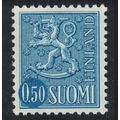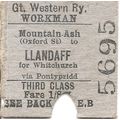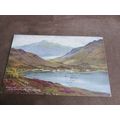St. Michael's Mount, Cornwall - Chevy Chase Room -Photochrom real photo postcard
- Condition : Used
- Dispatch : 2 Days
- Brand : None
- ID# : 138006845
- Quantity : 1 item
- Views : 467
- Location : United Kingdom

- Seller : justthebook (+1703)
- Barcode : None
- Start : Mon 30 Mar 2015 00:47:21 (BST)
- Close : Run Until Sold
- Remain : Run Until Sold
More Listings from This Seller view all
Seller's Description
- Postcard
- Picture / Image: St. Michaels Mount, Cornwall - The Chevy Chase Room - looks like real photo type
- Publisher: Photochrom Co. Ltd.
- Postally used: no
- Stamp: n/a
- Postmark(s): n/a
- Sent to: n/a
- Notes / condition:
Please ask if you need any other information and I will do the best I can to answer.
Image may be low res for illustrative purposes - if you need a higher definition image then please contact me and I may be able to send one. No cards have been trimmed (unless stated).
------------------------------------------------
Postage & Packing:
Postage and packing charge should be showing for your location (contact if not sure).
No additional charges for more than one postcard. You can buy as many postcards from me as you like and you will just pay the fee above once. Please wait for combined invoice. (If buying postcards with other things such as books, please contact or wait for invoice before paying).
Payment Methods:
UK - PayPal, Cheque (from UK bank) or postal order
Outside UK: PayPal ONLY (unless otherwise stated) please. NO non-UK currency checks or money orders (sorry).
NOTE: All postcards are sent in brand new stiffened envelopes which I have bought for the task. These are specially made to protect postcards and you may be able to re-use them. In addition there are other costs to sending so the above charge is not just for the stamp!
I will give a full refund if you are not fully satisfied with the postcard.
----------------------------------------------
Text from the free encyclopedia WIKIPEDIA may appear below to give a little background information (internal links may not work) :
*************
St Michael's Mount (Cornish: Karrek Loos yn Koos,[1] (Carrek Los yn Cos), meaning ""hoar rock in woodland"",[2] also known colloquially by locals as simply the Mount is a small tidal island in Mount's Bay, Cornwall, United Kingdom. The island is a civil parish and is linked to the town of Marazion by a man-made causeway of granite setts, passable between mid-tide and low water. It is managed by the National Trust, and the castle and chapel have been the home of the St Aubyn family since approximately 1650. The earliest buildings, on the summit, date to the 12th century, the harbour is 15th century and the village and summit buildings were rebuilt from 1860 to 1900, to give the island its current form.[3]
Its Cornish language name — literally, ""the grey rock in a wood"" — may represent a folk memory of a time before Mount's Bay was flooded, indicating a description of the Mount set in woodland. Remains of trees have been seen at low tides following storms on the beach at Perranuthnoe, but radiocarbon dating established the submerging of the hazel wood at about 1700 BC.[4]
Historically, St Michael's Mount was a Cornish counterpart of Mont Saint-Michel in Normandy, France (which shares the same tidal island characteristics and the same conical shape), when it was given to the Benedictines, religious order of Mont Saint-Michel, by Edward the Confessor in the 11th century.[5]
St Michael's Mount is one of forty-three (unbridged) tidal islands which can be walked to from mainland Britain and part of the island is designated as a Site of Special Scientific Interest in 1995 for its geology.[6][7]
There is evidence of people living in the area during the Neolithic (from circa 4000 to 2500 BCE years) with the discovery of a leaf-shaped flint arrowhead, which was found in a shallow pit on the lower eastern slope and now within the modern gardens. Other pieces of flint have been found, and at least two could be Mesolithic (circa 8000 to 3500 BCE).[3] During the Mesolithic, Britain was still attached to mainland Europe via Doggerland, and archaeologist and prehistorian Caroline Malone noted that during the Late Mesolithic, the British Isles were something of a ""technological backwater"" in European terms, still living as a hunter-gatherer society whilst most of southern Europe had already taken up agriculture and sedentary living.[8] At this time the Mount would likely to have been an area of dry ground surrounded by a marshy forest. Any Neolithic or Mesolithic camps are likely to have been destroyed by the later extensive building operations, but it is reasonable to expect the Mount to have supported either a seasonal or short-term camp for Mesolithic people.[3]
None of the flints, so far recovered, can be positively dated to the Bronze Age (circa 2500 to 800 BCE) although any summit cairns would have most likely been destroyed when building the castle. A hoard of copper weapons, once thought to have been found on the Mount, are now thought to have been found on nearby Marazion Marsh. Defensive stony banks on the north-eastern slopes are likely to date to the early 1st millennium BC, and are considered to be a cliff castle.[3] The Mount may be the Mictis of Timaeus, mentioned by Pliny the Elder in his Naturalis Historia (IV:XVI.104), and the Ictis of Diodorus Siculus.[citation needed] Both men had access to the now lost texts of the ancient Greek geographer Pytheas who, is said to have, visited the island in the fourth century BC. If this is true, it is one of the earliest identified locations in the whole of western Europe and particularly on the island of Britain, although the account of John of Worcester in the 11th century would point to this association being very unlikely.
It may have been the site of a monastery in the 8th – early 11th centuries and Edward the Confessor gave it to the Norman abbey of Mont Saint-Michel.[9] It was a priory of that abbey until the dissolution of the alien houses by Henry V, when it was given to the abbess and Convent of Syon at Isleworth, Middlesex. It was a resort of pilgrims, whose devotions were encouraged by an indulgence granted by Pope Gregory in the 11th century.
The monastic buildings were built during the 12th century and in 1275 an earthquake destroyed the original priory church, which was rebuilt in the late 14th century. It is still in use today. The priory was seized by the Crown, when Henry V went to war in France and it became part of the endowment for the Brigittine Abbey of Syon at Twickenham in 1424. Thus ended the connection with Mont St Michel.[9][10]
Henry Pomeroy captured the Mount, on behalf of Prince John, in the reign of Richard I. John de Vere, 13th Earl of Oxford, seized and held it during a siege of twenty-three weeks against 6,000 of Edward IV's troops in 1473. Perkin Warbeck occupied the Mount in 1497. Humphrey Arundell, governor of St Michael's Mount, led the rebellion of 1549. During the reign of Queen Elizabeth I, it was given to Robert Cecil, Earl of Salisbury, by whose son it was sold to Sir Francis Bassett. During the Civil War, Sir Arthur Bassett, brother of Sir Francis, held the Mount against the parliament until July 1646.
In 1755 the Lisbon earthquake caused a tsunami to strike the Cornish coast over 1,000 miles (1,600 km) away. The sea rose six feet in ten minutes at St Michael's Mount, ebbed at the same rate, and continued to rise and fall for five hours. The 19th-century French writer Arnold Boscowitz claimed that ""great loss of life and property occurred upon the coasts of Cornwall.""[11]
In the late 19th century the skeleton of an anchorite was discovered when a chamber was found beneath the castle's chapel.[citation needed] When the anchorite died of illness or natural causes, the chamber had been sealed off to become his tomb.[citation needed] The Mount was sold in 1659 to Colonel John St Aubyn. His descendant, Lord St Levan, continues to be the ""tenant"" of the Mount but has ceased to be resident there, his nephew, James St Aubyn, taking up residency and management of the Mount in 2004.
Little is known about the village before the beginning of 18th century, save that there were a few fishermen's cottages and monastic cottages. After improvements to the harbour in 1727, St Michael's Mount became a flourishing seaport, and by 1811 there were fifty-three houses and four streets. The pier was extended in 1821[12] and the population peaked in the same year, when the island had 221 people. There were three schools, a Wesleyan chapel, and three public houses, mostly used by visiting sailors. The village went into decline following major improvements to nearby Penzance harbour and the extension of the railway to Penzance in 1852, and many of the houses and buildings were demolished.
The Mount was fortified during the Second World War during the invasion crisis of 1940–41. Three pillboxes can be seen to this day.[13]
Sixty-five years after the Second World War, it was suggested based on interviews with contemporaries that the former Nazi foreign minister and one time ambassador to Britain, Joachim von Ribbentrop, had wanted to live on the Mount after the planned German conquest. Archived documents revealed that during his time in Britain in the 1930s, in which he had initially proposed an alliance with Nazi Germany, Ribbentrop frequently visited Cornwall.[14]
In 1954, the 3rd Baron St Levan gave most of St Michael's Mount to the National Trust, together with a large endowment fund.[citation needed] The St Aubyn family retained a 999-year lease to inhabit the castle and a licence to manage the public viewing of its historic rooms. This is managed in conjunction with the National Trust.
type=real photographic (rp)
city/ region=st. michaels mount
period=post-war (1945 - present)
postage condition=unposted
number of items=single
size=standard (140x89mm)
Listing Information
| Listing Type | Gallery Listing |
| Listing ID# | 138006845 |
| Start Time | Mon 30 Mar 2015 00:47:21 (BST) |
| Close Time | Run Until Sold |
| Starting Bid | Fixed Price (no bidding) |
| Item Condition | Used |
| Bids | 0 |
| Views | 467 |
| Dispatch Time | 2 Days |
| Quantity | 1 |
| Location | United Kingdom |
| Auto Extend | No |




 for 1 item(s)
for 1 item(s)
















